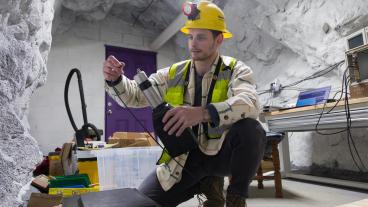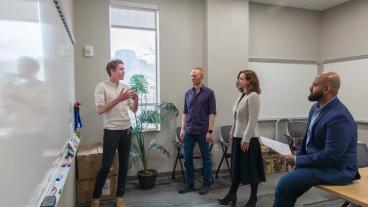 The acting deputy director of the U.S. Defense Advanced Research Projects Agency (DARPA) will join Colorado School of Mines early next year as the university’s vice president for research and technology transfer.
The acting deputy director of the U.S. Defense Advanced Research Projects Agency (DARPA) will join Colorado School of Mines early next year as the university’s vice president for research and technology transfer.
Dr. Stefanie Tompkins, who has spent the last decade in leadership and program management roles at DARPA, will oversee all research activity at Mines, serving as the public face of the university’s diverse research portfolio as it pushes to expand the reach and impact of the projects it conducts for industry and government. She will begin her new role in February 2018.
“Mines has always been a go-to place for solutions and knowledge, especially where our deep expertise in earth, energy and environment was needed,” said Mines President Paul C. Johnson. “In the future, we want our ideas, inventions and graduates to have even greater impact and value to people around the globe. Dr. Tompkins, with her unique background as a senior leader in what is arguably one of the most innovative and entrepreneurial federal R&D agencies, knows what is needed to get there. The Mines community is enthusiastic that Stefanie will be our new vice president for research and technology transfer at this pivotal time.”
“The world seems to be growing more complex every day, and we need new tools for the challenges posed by that complexity,” Tompkins said. “Many of those tools will come from universities like Mines—filled with people who like to really roll up their sleeves and stitch things together, from basic discovery to technology transition. I’m especially excited about Mines’ history of working with complex, multidisciplinary problems and getting new research discoveries into use in the broader world.”
A geologist by training, Tompkins has spent much of her professional career developing new technology capabilities. Before becoming DARPA’s acting deputy director in January 2017, Tompkins led the agency’s most exploratory unit, the Defense Sciences Office, accelerating research into new technologies for national security in fields as diverse as atomic physics, biochemistry and materials science. As a DARPA program manager, she initiated, led and managed the research and development of disruptive technology in navigation, manufacturing, optics, solar energy and body armor.
Tompkins began her technology career in the private sector, first with a small business and then as a senior scientist at Science Applications International Corporation (SAIC), where she conducted and managed research projects in planetary mapping, geology and imaging spectroscopy. She was a NASA principal investigator and on the science team for the Moon Mineralogy Mapper on India’s Chandrayaan-1 lunar orbiter, and later, as an SAIC assistant vice president and line manager, developed and successfully executed a multiyear plan for quadrupling the research revenues of a science and technology center.
Tompkins earned her master’s degree and PhD in geology from Brown University and holds a bachelor’s degree in geology and geophysics from Princeton University. She also served as a military intelligence officer in the U.S. Army.
“Dr. Tompkins’ breadth of experience managing science and technology and in-depth knowledge of several federal agencies that provide support for university research will be welcomed by Mines’ faculty as we continue to develop national reputation in innovative solutions to societal needs in earth, energy and environment,” said Wendy Harrison, chair of the faculty search committee and interim vice president for research and technology transfer.
Tompkins said she envisions Mines as a place where both curiosity-driven and use-inspired research thrive, cross-disciplinary conversations about new ideas are routine and entrepreneurship is embedded into the fabric of the research community.
“I’ve spent the majority of my career working with scientists and engineers and technologists across a wide variety of fields, from mathematics to materials science to autonomous systems. I also have lived in the world of research funding for a decade now—I think I have a good understanding of how people make their decisions on where to invest. I hope to use that experience to create new bridges between Mines researchers and opportunities for research funding and technology transition,” Tompkins said.
Specific opportunities will likely take time to emerge but Tompkins said one of her first steps will be to meet with every faculty member at Mines. On a personal note, she’s also looking forward to coming back to “a world where geology is a big deal.”
“I have not been around that for at least the last decade,” Tompkins said. “It feels like coming home.”
CONTACT
Emilie Rusch, Public Information Specialist, Communications and Marketing | 303-273-3361 | erusch@mines.edu
Mark Ramirez, Managing Editor, Communications and Marketing | 303-273-3088 | ramirez@mines.edu



